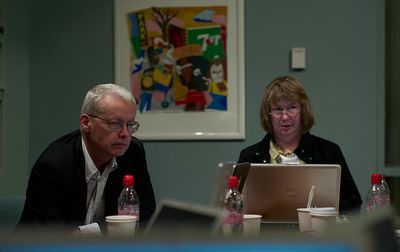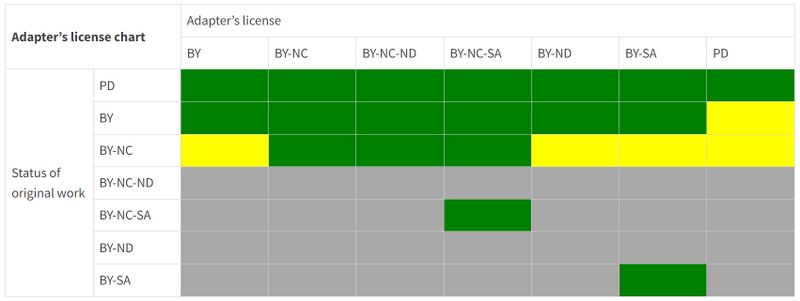Use multiple Creative Commons licensed works
When you use multiple Creative Commons licensed works to create a larger, original work that is also protected by copyright, the terms of the individual licenses must be considered when assigning a license to the larger work. These considerations differ depending on whether the larger work is a collection or an adaptation of the gathered works.
Collections
It's not uncommon to include multiple Creative Commons (CC) licensed resources, in their original form, in a single work (e.g., a PowerPoint presentation, a course module, an open textbook). This includes creations centered on the intentional collection and organization of a set of resources (e.g., anthologies, galleries, or repositories). If the CC licensed works are not changed, adapted, or remixed and the larger work simply presents copies of those individual works in their original form, then proper attribution and compliance with any non-commercial terms are all that's required. Elements original to the creator (e.g., the organizational structure of the larger work, supporting text) can be licensed independently without affecting the terms of the preexisting licenses on any of the collected assets.
Sample Collection
This is a collection of CC-licensed images of people who played an important role in the history of Creative Commons. Each image includes attribution using the TASL guideline (title, author, source, license).
Fig 1. Lawrence Lessig, the founder of Creative Commons. Larry Lessig, Robert Scoble, Flickr, CC BY 2.0
Fig 2. Eric Eldred, the lead plaintiff in the Supreme Court Case against the Copyright Term Extension Act. Eric Eldred and Diane Cabell, Joi Ito, Flickr, CC BY 2.0.
Fig 3. Sonny Bono, the person for whom the Copyright Term Extension Act was named. Sonny Bono, John Mathew Smith, Flickr, CC BY-SA-2.0.
Adaptations
Licensing a larger work that includes adaptations of multiple CC-licensed works can be complicated. A more detailed treatment of the term, "adaptation," and related CC licensing issues can be found in Chapter 4.4: Remixing CC-Licensed Work in the Creative Commmons Certificate for Educators, Academic Librarians, and GLAM open textbook. This resource defines an adapted (aka, remix, derivative) work as something "sufficiently original," created from a copyrighted work. Aside from determining how much change constitutes adaptation and properly attributing the individual assets adapted, the CC licenses of each individual work should be compatible with each other and with the so-called Adapter's License you assign to the larger work. The following general rules are offered:
- If you are adapting resources with NoDerivative restrictions, you can't share your adapted work with anyone.
- If you are adapting resources with ShareAlike restrictions, your Adapter's License must have a ShareAlike restriction.
- If you are adapting resources with NonCommercial restrictions, your Adapter's License should have a NonCommercial restriction.
Helpful charts
Creative Commons provides two very useful charts to help creators analyze the compatibility of multiple CC-licensed resources internally and with the various Adapter's Licenses prior to developing an adaptation. Use the first chart (Fig 1) to determine if two assets can be included in an adaptation based on their CC licenses. Use the second chart (Fig 2) to determine if a specific Adpater's License can be applied to the larger work if it includes an adaptation of a resource with a specific CC license.
Fig 1. CC License Remix Chart. Creative Commons, Frequently Asked Questions, CC BY 4.0.
Fig 2. CC Adapter's License Chart. Creative Commons, Frequently Asked Questions, CC BY 4.0.
Except where otherwise noted, text is available under the Creative Commons Attribution-NonCommercial-ShareAlike 4.0 International License.




